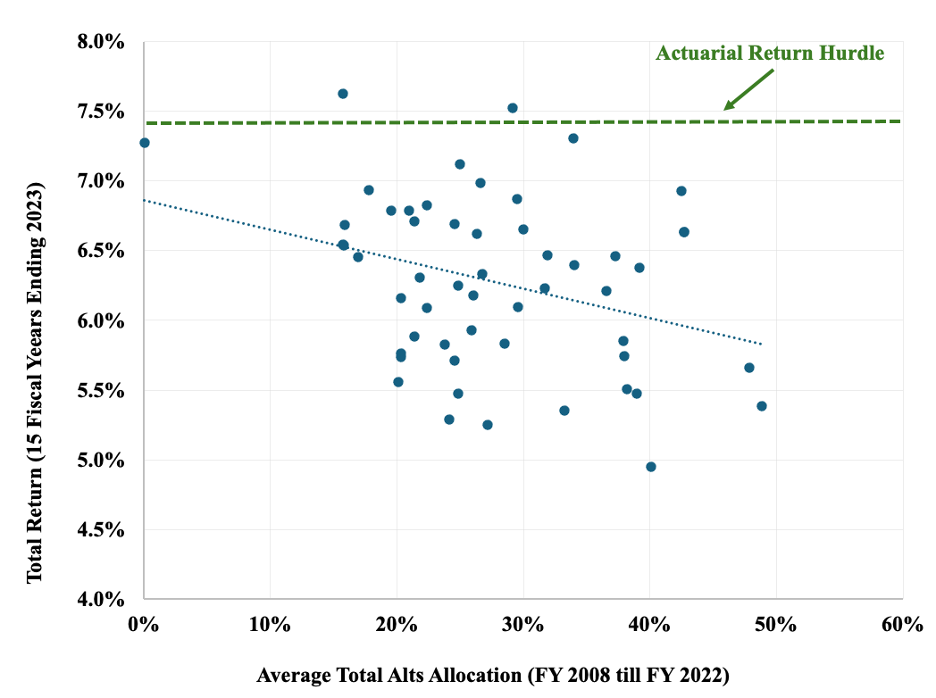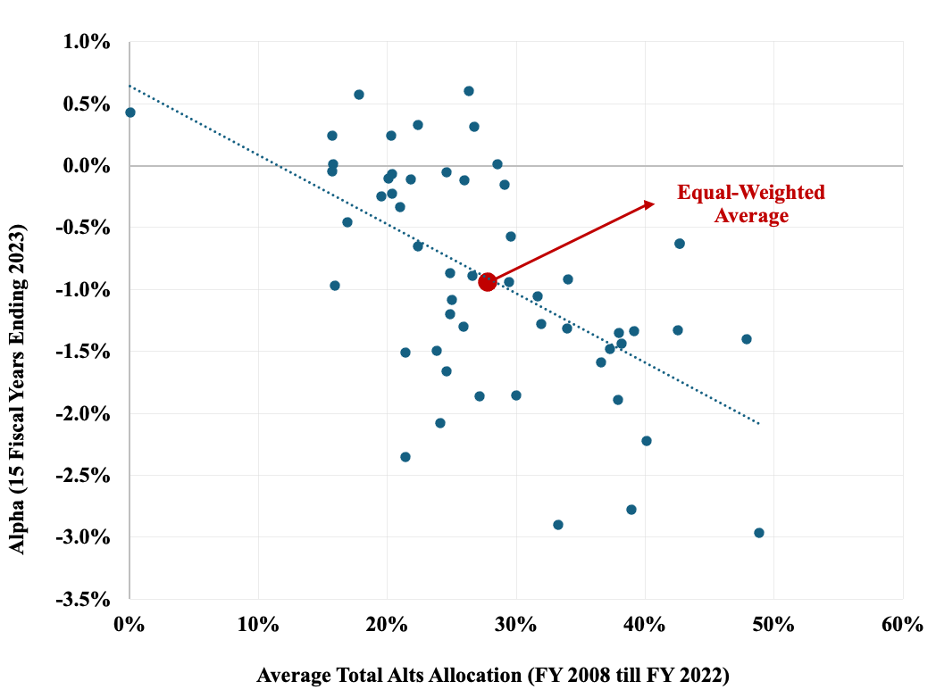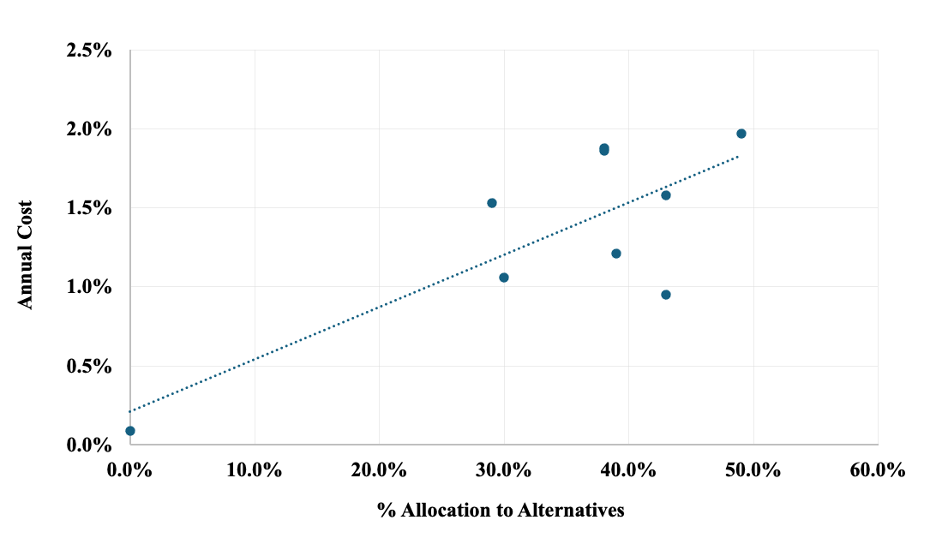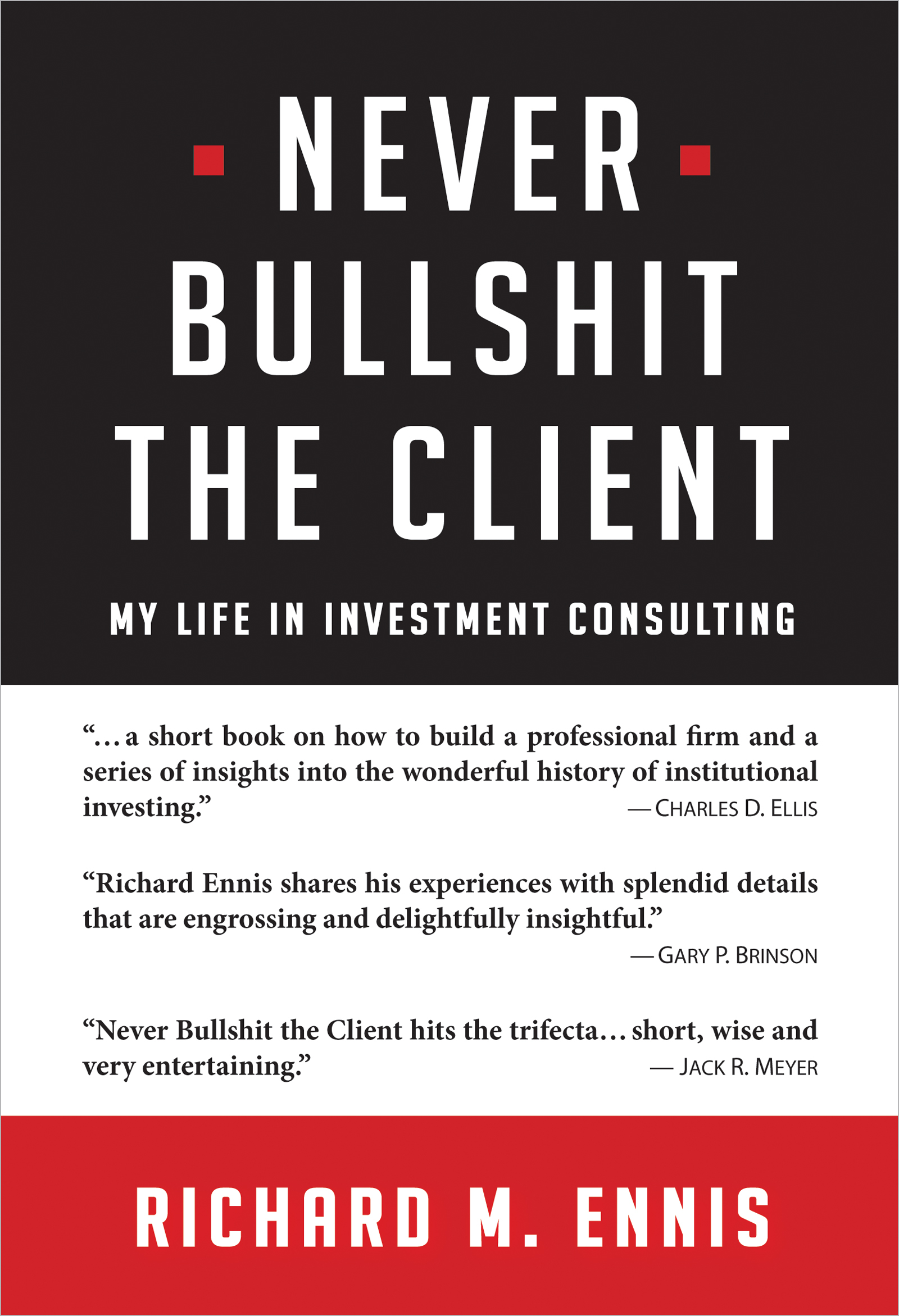How Hidden Costs Undermine Public Pensions in the US
The overarching strategic investment theme of public pension plans in recent years has been the emphasis placed on alternative investments, such as private equity, private real estate and hedge funds. Exhibit 1 illustrates the growth of alternative investments over the last 15 years. As a percentage of total public pension assets nationally, they grew from 18% to 34% over the period.
Exhibit 1
Public Pensions’ Allocation to Alternative Investments (%)
|
Year |
Private Equity |
Real Estate |
Hedge Funds |
Com- modities |
Misc. Alts |
Total Alts |
|
2008 |
7 |
7 |
2 |
1 |
1 |
18 |
|
2009 |
7 |
6 |
3 |
1 |
1 |
18 |
|
2010 |
8 |
6 |
3 |
1 |
1 |
19 |
|
2011 |
9 |
7 |
4 |
1 |
1 |
22 |
|
2012 |
9 |
8 |
5 |
1 |
1 |
24 |
|
2013 |
9 |
8 |
5 |
1 |
1 |
24 |
|
2014 |
8 |
8 |
6 |
1 |
1 |
24 |
|
2015 |
8 |
8 |
7 |
1 |
1 |
25 |
|
2016 |
8 |
9 |
7 |
2 |
1 |
27 |
|
2017 |
8 |
8 |
7 |
2 |
1 |
26 |
|
2018 |
9 |
8 |
7 |
2 |
1 |
27 |
|
2019 |
9 |
9 |
7 |
2 |
1 |
28 |
|
2020 |
9 |
9 |
6 |
2 |
1 |
27 |
|
2021 |
11 |
8 |
6 |
2 |
2 |
29 |
|
2022 |
13 |
10 |
7 |
2 |
2 |
34 |
Source: Public Plans Data, Center for Retirement Research, Boston College
Advocates claim these investment markets are less efficient than public markets. They believe that public pension funds would be a beneficiary of this economic inefficiency by hiring more skillful investment managers than other market participants. They argue that the returns of alts, as they are known, are “uncorrelated” with stocks and bonds, providing a valuable diversification benefit—increasing return while dampening volatility. That is the backdrop of the trend of public pensions in the US investing heavily in alts.
FALLING SHORT OF THE ACTUARIAL EARNINGS ASSUMPTION
Public pension trustees commonly say that their top investment priority is to realize a return at least as great as the actuary’s earnings assumption. Public plans in the US have sizable unfunded liabilities. Meeting the actuary’s earning assumption offers hope in the eyes of trustees and administrators for improving the plans’ security.
So, how have they done? I studied public fund performance for the period June 30, 2008, to June 30, 2023.[1] The average stated actuarial earnings assumption of public pension plans during the past 15 years was 7.4%.[2] During that period, a sample of 54 large public pension plans that report their return net of all expenses[3] had an average annualized total return of 6.3%, which fell short of the average actuarial earnings figure by about a percentage point. Only 2 of the 54 plans achieved a return greater than 7.4%. (In other periods, depending on the starting and endpoints, the plans did earn a return greater than the actuarial figure.) Of particular interest here is understanding how alternative investments influenced the outcome.
Exhibit 2 shows the relationship between the funds’ rates of total return and their average percentage allocation to alts over time.[4] The downward-slopping line of best fit graphically summarizes the statistical relationship during the study period. Increasing the alts allocation had the effect of depressing realized rates of return. Increments of 10 percentage points in the allocation to alts are associated with a statistically significant 21-bps reduction in annual total return. Superimposed in Exhibit 2 is a horizontal line indicating the average actuarial return assumption of 7.4%, which helps illustrate the adverse effect of alt-investing vis-à-vis the goal of meeting or exceeding the actuarial return assumption. Whatever benefits that might have been derived from investing in alts, advancing the goal of achieving the actuarial return figure was not among them. We explore the reason for this later.
Exhibit 2
Total Return vs. Allocation to Alts
(2009-2023)

FAILING TO GARNER ALPHA
Trustees have been especially interested in meeting the actuaries’ return assumption for the sense of financial security they infer from doing so. The CIOs of large funds have been eager to beat the market with pension investments to demonstrate that they are adding value. By “adding value” I am referring to earning a return in excess of a market-related benchmark. Such an excess return is often referred to by the shorthand term, “alpha.” It is a form of risk-adjusted return.
Exhibit 3 shows the relationship of alpha and the percentage allocation to alts for the 54 individual funds over the same time period as above. This alpha is the annualized return in excess of that of a hybrid index with matching market exposures and the same standard deviation of return as the subject fund.[5] For every 10-percentage-point increase in the allocation to alts, there is a statistically significant 56-bps reduction in annualized alpha. It would be fair to say that alternative investments have been an alpha killer of major proportions. By means of canny benchmarking, though, most funds manage to largely obscure the performance shortfall. But that is another story.[6] By this objective standard, public pension plans have performed poorly as active investors, and the main reason is their allocation to alternative investments.
Exhibit 3
Alpha vs. Alts Allocation Percentage
(2009-2023)

THE CULPRIT: COST
A dictum in the field of finance goes like this: To the extent markets are efficient, diversified portfolios will underperform properly constructed benchmarks by their margin of cost. I have found this rule of thumb helpful in interpreting the performance of investment portfolios. Unfortunately, good cost data for pension plans and endowments are hard to come by.
Public pension plans in the US notoriously underreport their investment expenses. (This is true in spite of the fact that most report a portion of their expenses in agonizing detail.[7]) CEM Benchmarking estimates that these plans underreport investment expenses overall by more than half.[8] I was able to identify a handful of plans that appear to make a good faith effort to report their expenses fully, including management fees, carried interest and other amounts deducted from distributions to LPs. Exhibit 4 summarizes their reported alts’ allocations and estimates of total annual cost.[9]
Exhibit 4
Alts Allocation and Cost for Nine Public Pension Funds
|
Pension Plan |
Allocation to Alts |
Estimated Annual Total Cost |
|
1 |
0% |
0.1% |
|
2 |
29 |
1.5 |
|
3 |
30 |
1.1 |
|
4 |
38 |
1.9 |
|
5 |
38 |
1.9 |
|
6 |
39 |
1.2 |
|
7 |
43 |
1.6 |
|
8 |
43 |
1.0 |
|
9 |
49 |
2.0 |
Using these limited data, I created a rough-and-ready model to explain investment expenses as a function of the aggregate allocation to alts. Exhibit 5 is the result. Even this small sample produces a fairly robust explanatory equation: 63% of the variation in cost is explained by a single figure, namely, the percentage allocation to alternative investments.[10]
Exhibit 5
Relationship of Cost and Allocation to Alts, 2009-2023

Exhibit 6 summarizes these results in tabular form.
Exhibit 6
Implied Cost
|
Allocation to Alts (%) |
Estimated Annual Cost (bps) |
|
10 |
54 |
|
20 |
87 |
|
30 |
120 |
|
40 |
153 |
|
50 |
186 |
Public funds’ current allocation to alts averages between 30% and 40% of total assets. With few exceptions, the funds use an average of more than 100 actively managed portfolios. The math of active management tells us that it is extremely unlikely that funds with this kind of diversification, and costs between 120 and 150 bps annually, will beat the market. And yet, we persist.
SUMMARY
Alternative investments have hindered pension trustees’ efforts to achieve the actuarial return assumption over the past 15 years. At the same time, alts have produced huge negative alpha. Failing to disclose investment expenses doesn’t eliminate them. The simple truth is that, today, alternative investing is carried out in highly competitive markets by countless smart players at far too great a cost to be tenable. The cost of managing public pension funds should decline from 100 bps or more annually to just a handful. If you understand just one thing about alternative investing, it should be the cost and its consequences.
REFERENCES
Center for Retirement Research, Boston College: Public Plans Data (https://publicplansdata.org)
Ennis, R.M. 2022. “Cost, Performance, and Benchmark Bias of Public Pension Funds in the United States: An Unflattering Portrait.” Journal of Portfolio Management.
——. 2023. “Lies, Damn Lies, and Benchmarks: An Injunction for Trustees.” The Journal of Investing 32 (4) 6-16.
Halim, S., and M. Reid. 2020. “Asset Owners Report Half of All Costs.” Top 1000 Funds, November.
[1] I begin the analysis in fiscal year 2009 in consideration of a significant issue affecting earlier years’ data. Prior to an accounting rule change in 2008, private assets were valued at book. The rule change required that a market-basis of valuation be used. I find evidence of return smoothing of institutional investment returns prior to 2009 that ceases to exist after the rule change. The return smoothing appears to have created an upward bias in public pension fund returns in the period 2001 to 2008. So, I start with 2009, which coincides with the Great Financial Crisis (GFC) of 2008. The GFC itself was a watershed event for asset pricing. Reported returns for FYs 2022 and 2023 exhibit an exceptional degree of return smoothing owing to the use of stale NAVs in their calculation. I unsmothed these returns using observed market exposures for the preceding 13-years, combined with market returns for the two recent years. This gives us the “beta” portion of returns.
[2] The source of the actuarial assumption data is: Public Plans Data, Center for Retirement Research, Boston College: https://publicplansdata.org/quick-facts/national/
3 A number of large public pension plans do not fully net investment expenses from publicly reported rates of return. According to the Pew Trusts, state pension plans reporting returns gross of fees as of fiscal 2021 were the Alabama SRS, Alabama TRS, Arkansas PERS, Delaware PERS, Georgia ERS, Hawaii ERS, Idaho PERS, Kentucky TRS, Louisiana SERS, Louisiana TRS, Massachusetts PRIM, Mississippi PERS, Nevada PERS, Oklahoma PERS, Texas ERS, and Utah RS. https://www.pewtrusts.org/en/research-and-analysis/issue-briefs/2023/10/transparency-in-investment-disclosures-helps-promote-effective-public-pension-administration
[4] The source of asset allocation data is Public Plans Data, Center for Retirement Research, Boston College: https://publicplansdata.org/api/?q=getchartdata&format=csv&chart=nationalassetallocation
[5] The hybrid index is determined by means of quadratic programming, with independent variables Russell 3000 stocks, MSCI ACWI ex-US stocks (hedged and unhedged), and Bloomberg Barclays US Aggregate bonds. Resulting proportions are 50%, 13%/9% and 28%, respectively.
[6] See Ennis (2022 and 2023).
[7] A standard disclosure of public pension plans is the amount of investment expenses incurred during the fiscal year. These presentations are notoriously vague about what is included as an element of cost. Often a cost figure is provided for every investment manager and LP, which can run into the hundreds. What is normally reported are management fees billed to and paid by the fund. Typically excluded is carried interest and any other expenses that GPs deduct from distributions to LPs. A fig leaf of full disclosure sometimes takes the form of a statement to the effect that all expenses “billed to the plan” are being reported. Carried interest and deductions from distributions, of course, are not “billed” to LPs. They simply disappear via deductions by the GP.
[8] See Halim and Reid (2020), citing CEM Benchmarking (https://www.top1000funds.com/2020/11/asset-owners-report-half-of-all-costs/ estimates).
[9] In alphabetical order, the plans are CalSTRS, Georgia Teachers, Illinois Teachers, Missouri SERS, Missouri Schools, New Mexico Educational, Pennsylvania Public Schools and South Carolina.
[10] The equation is y = 0.0331x + 0.0021, where y is cost, and x is allocation to alts.

